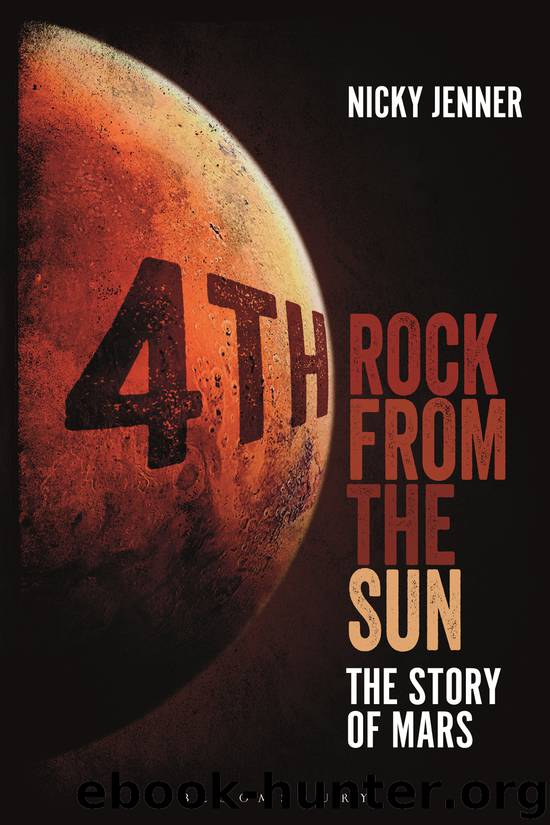4th Rock from the Sun by Nicky Jenner

Author:Nicky Jenner
Language: eng
Format: epub
Publisher: Bloomsbury Publishing
The birth of Phobos and Deimos
Firstly, and perhaps most famously, is the idea that Phobos and Deimos aren’t really related to Mars at all: they’re actually adopted asteroids that were captured by the planet at some point in its history. Mars may have managed to snag a couple of single nearby objects, pilfered one of the objects in a duo as the pair flew past (this would have had to happen twice, once for Phobos and once for Deimos), or grabbed a single object that later split into two post-capture. The objects captured by Mars could have been from the inner or outer Solar System or from the main asteroid belt; each of these scenarios would result in a different composition for Phobos and Deimos, with a different internal structure and mix of water, organics and minerals.
Initially, this looks appealing; the moons’ spectra do suggest that both bodies may have similar compositions to asteroids, and Mars does sit close to the asteroid belt. In order to be asteroid-like, the moons must have swept up material that lies far beyond Mars’s orbit, implying that they didn’t form where they currently live. However, there are a few issues with this, including the fact that capturing an intact object is actually a very, very unlikely event – and for Mars, it would have to have happened not once, but twice.
The behaviour of the moons themselves throws up additional hurdles for this theory. Both have properties that are difficult to reconcile with them being captured asteroids. Both Phobos and Deimos have orbits that are very circular (in fact, almost perfectly circular), prograde (meaning they orbit in the same direction as Mars rotates, anticlockwise, like the vast majority of bodies in the Solar System) and very closely aligned with Mars’s equatorial plane (known as ‘low inclination’ orbits).
These orbits are very difficult to explain if we assume the moons to be snagged passers-by. Such bodies would likely be disruptive and travelling on any number of differently aligned orbits. An incoming asteroid could approach from a range of directions and inclinations. In order for the current orbits of Phobos and Deimos to be so well behaved, they must have been altered, reshaped, realigned and circularised over time. This would have required Mars to have a very thick primitive atmosphere, not only to considerably alter the moons’ orbits, but so that the planet was capable of removing the excess energy from the passing bodies after it hooked them to slow them down.
Crucially, this thick atmosphere would have had to dissipate rapidly at just the right time in order to avoid either ripping the new moons apart or pulling them down to crash into the surface of Mars. While this is all possible, it requires some precise timings and is therefore unlikely, particularly for Deimos. Phobos is so close to Mars that atmospheric drag could potentially have had this kind of effect, but Deimos exists much further away from Mars. To apply to both moons, Mars’s super-thick primitive atmosphere would thus need to have been far-reaching, too.
Download
This site does not store any files on its server. We only index and link to content provided by other sites. Please contact the content providers to delete copyright contents if any and email us, we'll remove relevant links or contents immediately.
| Aeronautics & Astronautics | Astronomy |
| Astrophysics & Space Science | Comets, Meteors & Asteroids |
| Cosmology | Mars |
| Solar System | Star-Gazing |
| Telescopes | UFOs |
Tools of Titans by Timothy Ferriss(8308)
Turbulence by E. J. Noyes(7983)
Secrets of Antigravity Propulsion: Tesla, UFOs, and Classified Aerospace Technology by Ph.D. Paul A. Laviolette(5336)
Astrophysics for People in a Hurry by Neil DeGrasse Tyson(5153)
Room 212 by Kate Stewart(5073)
Design of Trajectory Optimization Approach for Space Maneuver Vehicle Skip Entry Problems by Runqi Chai & Al Savvaris & Antonios Tsourdos & Senchun Chai(5040)
Pale Blue Dot by Carl Sagan(4960)
The David Icke Guide to the Global Conspiracy (and how to end it) by David Icke(4658)
A Journey Through Divination and Astronomy by Publishing Pottermore(4364)
Goodbye Paradise(3767)
Apollo 8 by Jeffrey Kluger(3672)
COSMOS by Carl Sagan(3592)
The Five People You Meet in Heaven by Mitch Albom(3522)
Losing the Nobel Prize by Brian Keating(3521)
How to Read Water: Clues and Patterns from Puddles to the Sea (Natural Navigation) by Tristan Gooley(3434)
Brief Answers to the Big Questions by Stephen Hawking(3394)
How to Read Nature by Tristan Gooley(3294)
The Order of Time by Carlo Rovelli(3164)
A Brief History of Time by Stephen Hawking(2994)
